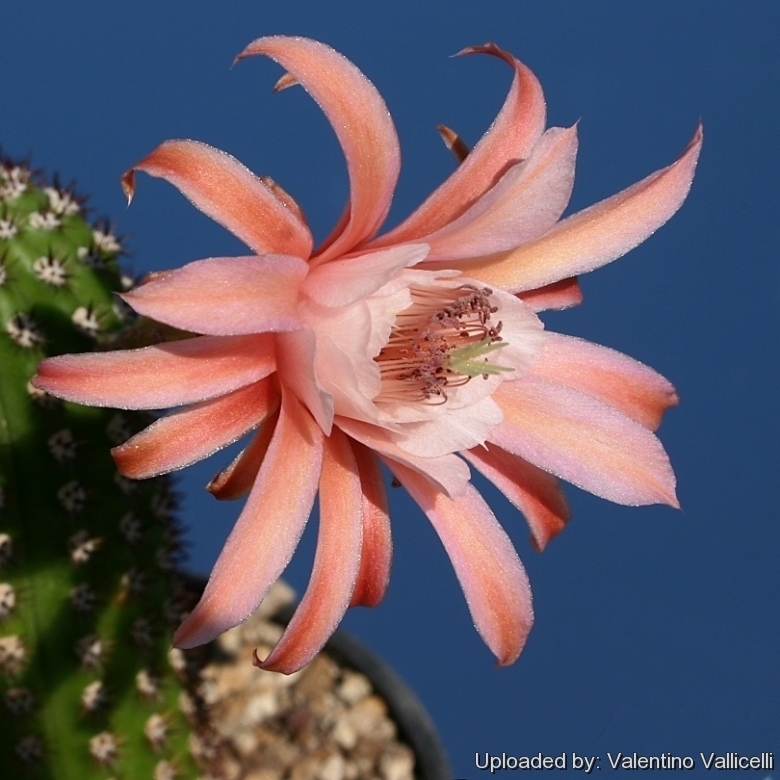
Cleistocactus cv. Nolle 2 Photo by: Valentino Vallicelli
Origin and Habitat: Garden origin (Nursery produced cultivar)
Synonyms:
Description: Cleistocactus cv. Nolle 2SN|3784]]SN|21271]] (best known as Hildewintera cv. Nolle 2SN|21272]]SN|21272]]) is a cute little prolific clumping cactus with arching, or trailing stems that can grow up to 1 m long and about 4 cm wide with many branches. It is an hybrid plant involving Cleistocactus winteriSN|21271]]SN|3784]] (the Golden Rat Tail) and an unknown Echinopsis sp. It produces a profusion of beautiful medium sized pink flowers at a time, and is quite a sight. Magnificent bloomers, the flowers can endure for two-three days (depending on temperature and sun exposure).
Flowers: Medium sized, short-tubed.
Inner tepals: Delicate pink-white.
Outer tepals: Thin almost linear, reflexed, pink with salmon-pink midribs.
Filaments: Pink.
Anthers: brownish-violet.
Stigma lobes: Greenish.
Subspecies, varieties, forms and cultivars of plants belonging to the Cleistocactus hybrid (Hildewintera) group
Notes: HILDEWINTERA HYBRIDS: Hildewimtera aureispina (now renamed Cleistocactus winteriSN|3784]]SN|3784]]i) is an old species that can be hybridized with various cactus of several different genus (Among them: {{Echinopsis, Lobivia, Matucana}}, etc) giving rise to some intergeneric hybrids.
Hildewintera hybrid develops really amazing flowers of different colours on the original pendulous "hildewintera" body and many of these hybrids have cultivar names. This plants form soon spectacular clumps with several flowers at a time and are quite a sight.
Remarks: They are often thicker, stronger, larger growing than H. aureispina and tend not to have the typical thin stemmed offsets. The offsets produced are more strongly attached to the main stems.
 Cleistocactus cv. Nolle 2 Photo by: Cactus Art
Cleistocactus cv. Nolle 2 Photo by: Cactus Art Cleistocactus cv. Nolle 2 Photo by: Valentino Vallicelli
Cleistocactus cv. Nolle 2 Photo by: Valentino Vallicelli Cleistocactus cv. Nolle 2 Photo by: Valentino Vallicelli
Cleistocactus cv. Nolle 2 Photo by: Valentino Vallicelli Cleistocactus cv. Nolle 2 Photo by: Cactus Art
Cleistocactus cv. Nolle 2 Photo by: Cactus Art Cleistocactus cv. Nolle 2 Photo by: Cactus Art
Cleistocactus cv. Nolle 2 Photo by: Cactus Art Cleistocactus cv. Nolle 2 Photo by: Cactus Art
Cleistocactus cv. Nolle 2 Photo by: Cactus Art Cleistocactus cv. Nolle 2 Photo by: Cactus Art
Cleistocactus cv. Nolle 2 Photo by: Cactus ArtSend a photo of this plant.The gallery now contains thousands of pictures, however it is possible to do even more. We are, of course, seeking photos of species not yet shown in the gallery but not only that, we are also looking for better pictures than those already present.
Read More... Cultivation and Propagation: Cleistocactus winteriSN|3784]]SN|3784]] (and hybrids) are of easy culture, making then good cactus for beginners. They are suited to hanging baskets as well as pots.
Soil: Use a loose well drained cactus mix.
Repotting: Since they are rapid growers need plenty of space for their roots, repotting with fresh potting-mix should be done every other year or when the plant has outgrown its pot. However, repotting doesn't necessarily mean they'll need larger containers.
Sun Exposure: Require filtered bright light, partial sun or light shade, but not in full sun that will sunscald it.
Watering: They require moderately watering through the growing season. This can be done weekly or more frequently during the summertime, if the weather is sunny enough, but allow to dry fully before watering again. Kept this way, plants will show a healthy growth. Keep rather dry as soon as the temperature starts dropping in October and keep it dry in winter. The plant survives outside without protection in winter (cold hardy to -2° ) but is then somewhat prone to rot, too.
Fertilization: Give an occasional high potassium liquid feed during the active growing period.
Hardiness: Winter care presents no problems at temperatures from 5 to 15 degrees centigrade with plenty of light, but frost hardy to -2°C for short periods if very dry. This plant needs a period of cool rest in winter to produce flowers abundantly. It flowers freely indoors too if conditions suit it.
Pest and diseases: They are generally fairly easy to grow, especially if kept pest-free. They are susceptible to, scale insects and spider mite. Watch carefully for infestations of stem and root mealy bugs, and damage from these may well initiate fungal attack.
Propagation: Easy to propagate from cuttings or seeds. Take cuttings spring or summer, let them dry till the ends callous well. Then replant them in fresh cactus soil that is ever so slightly moist, and keep it that way till they root. Surface sowing is the best; seeds germinate in 14-28 days at 20° C, remembering that seedlings dislike strong light and dry conditions.

















